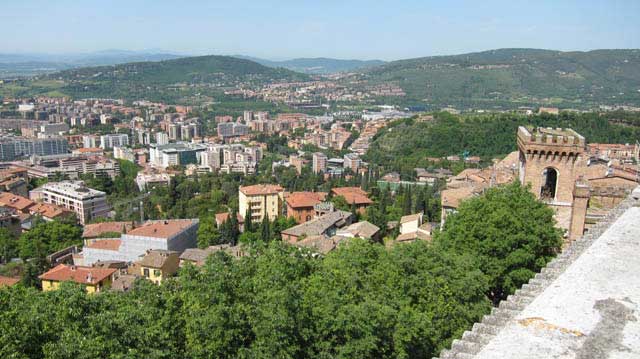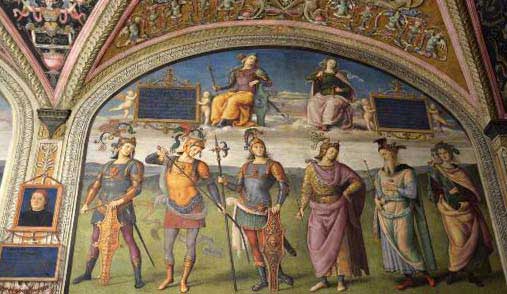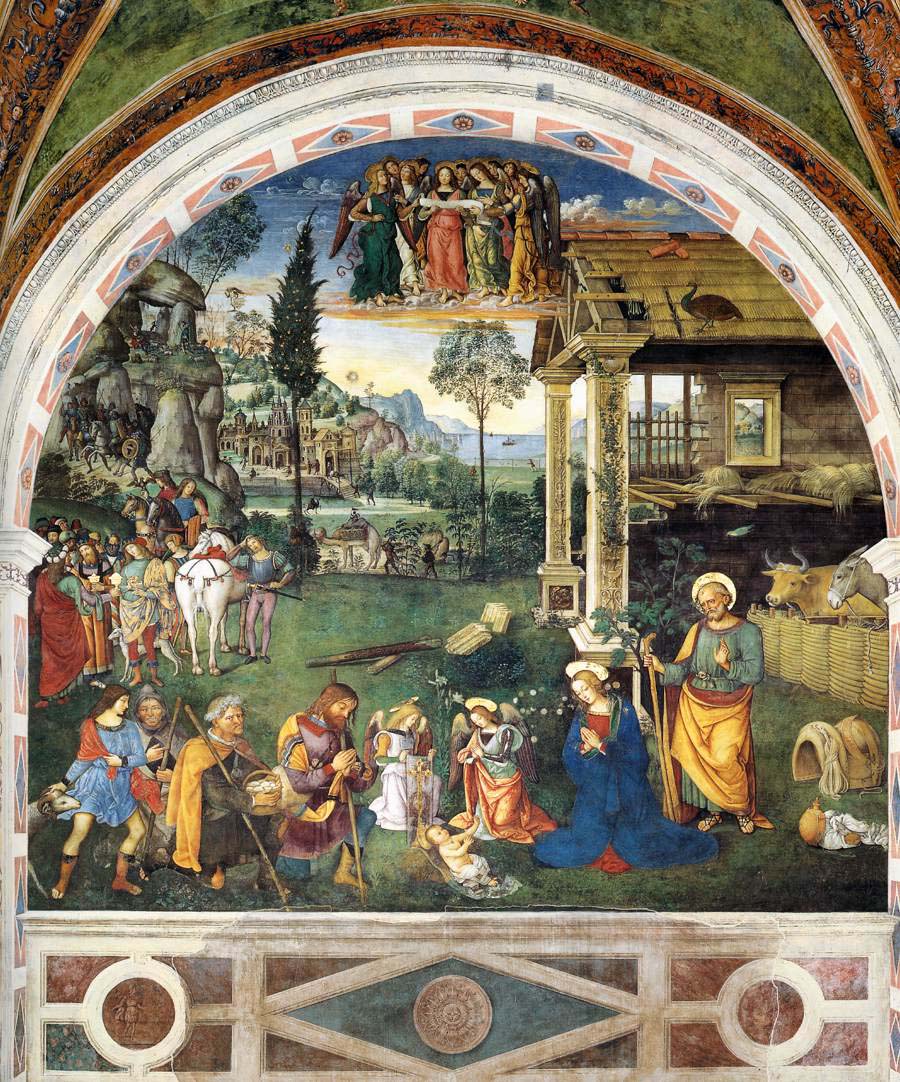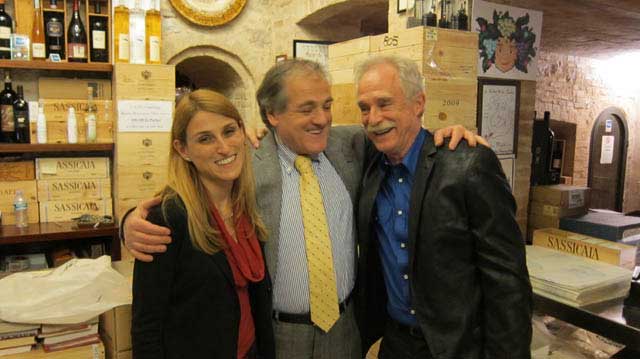A chance to speak at a law conference in Rome afforded my husband, Michael, and me, five days to explore another part of Italy. Why not Umbria, we thought? The green heart of Italy, between Rome and Florence, the region is home to the forests, lakes, and farmlands whose yields, especially truffles (both the noble mushroom and the chocolate-coated ice cream bombe known as a tartufo) wild boar, olive oil, and wine, are treasured throughout the country and beyond. Artistically, it is renowned for the great ceramics-works of the 15th and 16th centuries along with some of the most magnificent Renaissance frescoes still on the walls of the buildings where they were painted. Five days turned out to be scant time to discover the natural beauty and cultural riches on offer, in between memorable meals accompanied by some of the most interesting wines we have ever tasted.

In for a treat, we had come to Perugia not for Perugina, the world famous chocolatier based there, but for Perugino, as the great Renaissance painter Pietro Vannucci was known. Hearing this, our taxi driver from the Perugia train station was filled with enthusiasm for Perugino and other Renaissance masters whose names he rattled off as if they were all old friends. By the time we alighted at the Hotel Brufani Palace, our base of operations, he had generously bestowed on us a pile of guidebooks and was pointing out maps of the nearby towns where we could see works by his favorites. It seemed that everyone we met in Umbria was as enthusiastic as he was about the local must-sees.
Everyone included Antonio, maître d’ at the Brufani’s Collins Restaurant, whom we encountered a few minutes later. His lectern, positioned strategically between lobby and elevator to the guestrooms, allowed for maximum interaction with folks who might be in need of a dinner reservation. Tired and a bit cranky, in no time we were invited by Antonio to inaugurate our stay in Perugia with dinner and a sampling of local wines. One look at the menu and our plan for a quick snack was ditched in favor of guinea fowl stuffed with foie gras, truffles, and pecorino cheese for me, and sea bass in orange sauce with cauliflower flan for Michael, all cooked to perfection.
Antonio made sure we had a proper introduction to his beloved Umbrian wines, both red and white, but especially the Sagrantino di Montefalco based on a grape grown in the region for at least four hundred years but “rediscovered” by Arnoldo Caprai in the 1970s. Full-bodied, rich, balanced, with hints of berry and vanilla, the “dry” version of the wine could be our ideal red to accompany meals or just to sip. The passito version is an intense, sweet and fruity dessert wine, the perfect accompaniment to the Collins’ warm and creamy chocolate tortino and the chestnut concoction capping our meal that first evening.
Thanks to Antonio’s tutelage, we enjoyed repeatedly both versions of Sagrantino, along with Caprai’s blend of Sagrantino with other grapes (Sangiovese and Merlot) and known as Rosso di Montefalco. As we soon learned, it is essential to enjoy these remarkable wines in Umbria because it is such a memorable place, but also because they are difficult to find, even as nearby as Rome.
The Hotel Brufani Palace proved to be a marvel and the ideal headquarters for our visit. Eschewing the trend to sterile soullessness of other places we have stayed in Italy, this Sina Group property evokes classic elegance and luxury at an affordable price, with attentive and gracious service. Our room featured a sweeping vista to the northwest while just down the corridor was a large covered patio offering a panoramic view of the region and nearby towns. It proved the perfect spot to relax in the evening with a glass of Sagrantino and reflect on the day’s adventures.
Everywhere we gazed in Umbria there were free-standing bell towers rising above the churches for which they were built. Centuries before Italy became a nation, the towns or communes were self-governing cities in a seemingly constant state of war with one another from the 11th century until taken over by the Papacy in the mid-14th century. A bell tower was always built before its church because the locals needed a vantage point from which to determine if the neighboring town was about to attack and, if so, to use the bell and sound the alarm. Anne Robichaud, expert on Umbria and friend of a client of mine in Houston, explained all this as she guided us on a tour through Assisi.

Among the works by Perugino that we had come to see were the frescoes in the Collegio del Cambio in Perugia, commissioned by the money changer’s guild in 1496. The guild’s members were responsible for exchanging local coinage for that of tradesmen visiting from other towns, each of which issued its own currency. Unlike today’s currency exchanges, the money changer’s responsibilities included assaying and weighing the coins to ensure they were not counterfeit and that they contained the requisite amounts of gold or silver.
Perugino’s frescoes, still present in the small rooms adorned with magnificently carved cabinetry, gave us a sense of what it meant to be an Umbrian artist. While depicting stories from the Bible these painters included, in the background, the countryside they saw around them. Even when painting in the Sistine Chapel and Papal Apartments in the Vatican, they brought the natural beauty of their region with them for all the world to see. Valleys, lakes, hillsides sprinkled with castles and towns, all recede into a deep distance dotted with trees and bathed in pastel shades of blue and gray under the canopy of a pale yellow sky. No matter the narrative, the tranquil landscape beckons and draws the viewer into the drama being acted out in the foreground.
Needing a restorative pastry and coffee after visiting the Collegio del Cambio and the National Gallery of Umbria next door, we crossed the street and headed for Sandri, the pastry and chocolate emporium dating back to 1860 and still owned by the founding family. Echoing the theme of the Collegio del Cambio, the ceiling is beautifully painted, the walls lined with ornate walnut cabinets. And if you offer a 20 euro note in payment, it will be run through an electronic device to verify that it is genuine. The spirit of the Collegio del Cambio lives on in Perugia!

A rival and occasional collaborator with Perugino was responsible for the most interesting discovery of the trip, as part of our tour of Assisi and Spello with Anne. Standing at the opening of the U-shaped Capella Baglioni in the Church of Santa Maria Maggiore in Spello, we had the sense of shifting back in time some 500 years to when Bernardino di Betto, known as Pinturicchio (the short painter) glimpsed three blank walls and a vaulted ceiling for the first time. Within a few months, he had transformed the space into one of the most breathtaking and magnificent sets of frescoes produced in the Italian Renaissance, which is saying a lot considering the masterpieces of his contemporaries and successors such as Perugino, Raphael, Leonardo, etc.
Depicting the scenes from the life of Jesus including the Annunciation, the Nativity, and the Disputation at the Temple, these works incorporate magnificent architecture full of trompe l’œil elements as well as charming touches such as the rustic, half-finished manger from which the ox and ass peer over their pens at the simple shepherds and elaborately garbed magi come to visit the Baby Jesus. We found ourselves bowled over by Pinturicchio’s talents and accomplishments, but not before we ran out of the one euro coins needed to feed the meter so the lights would stay on in the chapel.
Worn out from sensory overload, we were whisked next door by Anne to Enoteca Properzio, the leading wine merchant in Umbria and one of the top purveyors of Italian wines worldwide. We were welcomed by Roberto Angelini and his daughter, Irene, who were our hosts for an evening of wine and foods from the region. Roberto was enthusiastic about having Texans visit since he had done several private tastings in Houston last year, including one in the Woodlands. We hope he comes back soon and brings his wonderful wines for a Wine Society tasting!

My favorite wine of the evening was the limited production Rosso Assisi 1997 Reserve Sangiovese. The nose full of earth was at first startling but then engaging when sipping this remarkable, full-bodied red wine. Michael’s favorite was the Sagrantino 25 Anni from Arnoldo Capri, the culmination of the vintner’s art using this native Umbrian grape. The wines were accompanied by slices of bread drizzled with superb local olive oils, bruschetta, bean soup, and assorted artisanal meats and cheeses.
Other memorable repasts included the following (pasta always fresh and home-made):
Taverna del Gusto in Deruta -- spelt salad (based on an ancient Roman grain still grown in the area), noodles wrapped with ham and cheese in a béchamel sauce with black truffles, pork fillets in black truffle sauce with oven-roasted potatoes
Ristorante del Sole in Perugia (with a magnificent view of the city) -- gnocchi in a duck sauce with duck bacon, noodles in a porcini mushroom sauce, wild boar ragout, tortino of chocolate and pear (Michael’s all-time favorite dessert from this trip)
Trattoria degli Umbri in Assisi -- wild boar steak with potatoes seasoned with “antique” fennel and the inevitable but scrumptious chocolate tartufo dessert
Thanks to the natural beauty of the countryside, the ancient towns, the friendly and enthusiastic inhabitants, and all the fabulous foods and wines, our visit to Umbria can be summed up in two words – joyous and harmonious. It all works wonderfully well together and, despite the stresses of travel, left us feeling relaxed and contented, eager to return.
Sandri, Corso Vannucci, 32, Perugia, PG 06121
Hotel Brufani Palace (Collins Restaurant), Piazza Italia 12, Perugia, PG 06121
Ristorante del Sole, Via Della Rupe, 1, Perugia, PG 06121
Enoteca Properzio, Piazza Giacomo Matteotti 8, Spello, PG 060
Trattoria degli Umbri, Piazza del Comune 2, Assisi, PG 06081 (no website)
Taverna del Gusto, Via Mastro Giorgio 5, Deruta, PG 06053 (no website)
Next time, capitalizing on porcini season in Rome.
The original version of this article appeared in the Spring, 2012 edition of the Quarterly Newsletter of the Wine Society of Texas, a non-profit organization dedicated to wine education and appreciation.